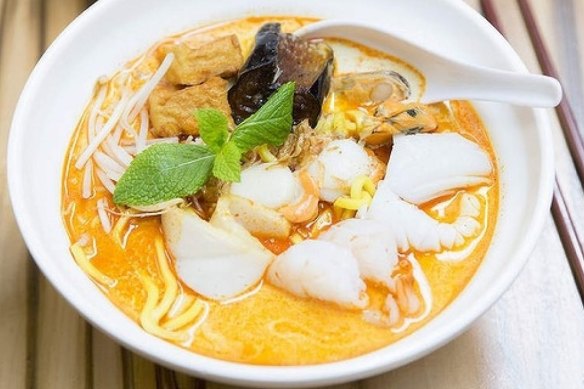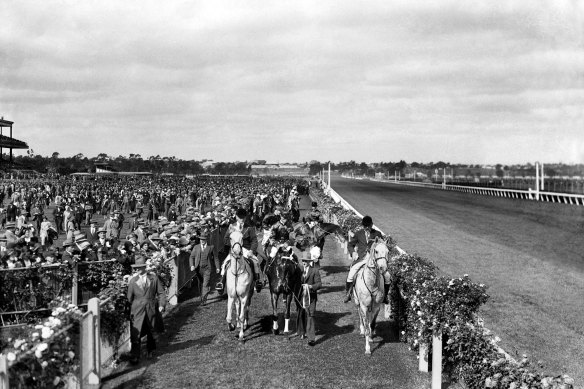This was published 9 months ago
Opinion
If Carlton North and Footscray had a love child, it would look like my suburb
Noel Newell
ContributorApparently, my suburb has a horse race. But those of us who live in Flemington know it is not a one-trick pony.
The race that stops a nation draws in both the modest punter and the pampered celebrity, and my suburb, too, is one of surprising contrasts. I like to think that if Carlton North and Footscray were to have an unlikely hook-up on a dark and stormy night, their love child would resemble Flemington.
Five kilometres north-west of the CBD, it’s home to upwardly mobile young professionals in their renovated period homes, adjacent to Melburnians of refugee background living in the concrete monoliths of public housing. Flemington’s rich spectrum of culture and wealth makes it the epitome of Melbourne’s inner city.
Four decades ago, I drove into Flemington and fell in love with its Victorian charm. It was a different planet to the Broadmeadows I grew up in. At that time, Broadie felt like a war-torn state after curfew, its desolate shopping strips attracting skinhead youth like moths to an outside toilet light.
I bought my first house in Flemington just a few weeks later, but not everyone was as enamoured as I was. One colleague derisively referred to it as North Abattoir, after the livestock facilities that were based just north of the city. Their comment would return to my mind in those early days whenever a southerly blew and the smell and sounds of cattle hung over the suburb.
Those markets and abattoirs are long gone, but history lingers in the pubs that remain. Long before the hipsters and parmas, the bars were frequented by abattoir workers, cattle traders and petty crims – and locals would give them a wide berth.
The Doutta Galla hotel, now a family-friendly bistro, was known as the “bloodbath”. Meanwhile, the beautiful bluestone Pastoral Hotel, a stalwart for the cattle saleyard, was mysteriously bulldozed one night in the mid-1980s, not long after the cattle bridge over Racecourse Road was removed.
At that time, Flemington was largely inhabited by working-class immigrants from Europe. I was part of the first wave of young renovators buying in the inner city as many of the immigrants left for the outer suburbs. They considered it a simple decision – why live in a bowling alley when you could have a spacious quarter-acre block?
Walking down Wellington Street, arguably one of the most beautiful and historic in Melbourne, and arriving at Racecourse Road is still like taking the lift in a swanky hotel and ending up in the basement boiler room.
Barry Humphries once said Racecourse Road was one of the most interesting streets in Melbourne. He was specifically a fan of the African restaurants, but it is possible for a street to be too real. You can walk along it any time of day and taste the grit in your teeth while the “town square” sits like a hernia on Flemington’s soft underbelly.
Flemington lies in the Moonee Valley Council municipality, but we are like the delinquent adopted lovechild separated at birth from our Kensington twin and raised by their natural Melbourne City Council parent. I suspect Moonee Valley would happily give us back as we seem to sit uncomfortably with their largely white middle-class demographic.
When my eldest boy went to the local Flemington Primary School in the early ’90s, there were 90 kids who all knew each other’s names and a caretaker lived on-site. These days the school has 400 students and is growing. Prams rule the paths outside the local cafes.
In some ways, I confess that I feel less at home now in Flemington than I ever have – I have grown old while Flemington has grown young. Flemington is blossoming – we have rescue greyhounds, electric cargo bikes, decaf soy chai lattes, tattooists, tattoo removalists, farmers markets, vegan parmas, and Adam Bandt.
But most importantly, we have laksa. We may in fact be the laksa capital of the world. If you somehow don’t know what laksa is, it is like a warm bowl of crack – one mouthful and it owns you. The queen of laksa is of course Laksa King, which appears to be open more hours than exist in a week. It has a permanent queue of punters outside waiting for a complete culinary sensory overload. Now every second cheap and cheerful in the hood provides the same chaotic experience.

The signature dish at Flemington’s Laksa King.Credit: Bonnie Savage
The postwar working-class generation is now long gone, as the privately schooled young professionals from the eastern suburbs who couldn’t afford to buy in Malvern have poured in. But because of high-rise public housing flats, there is something about Flemington that makes it stand still – in a good way. Despite the constant change and these contrasts, there is a strong community bond here.
That is why there was astonishment and outrage for many of us when the housing flats were locked down without notice during COVID. It felt like we lived in an apartheid state. I joined with some other locals to do food delivery one cold winter’s night and it was a scene of chaos, like something from Apocalypse Now. It still haunts me.
If you care to try to get a glimpse into a refugee’s life, you soon realise that everyone has an amazing story to tell. There are plans to demolish Flemington’s flats, but I hope that whatever replaces them, my suburb will retain its diverse character.
The contrasts of Flemington are never more evident than at spring carnival time, when hordes of the well-heeled gatecrash our suburb. Dishevelled champagne-soaked punters overrun our Asian and African eateries like some sort of exotic rash. The spring carnival is, for locals, like a reminder of a party you weren’t invited to. Like it or not, you have to put up with the annoyances of BMW traffic jams, wandering drunks, suited-up wankers and buzzing helicopters.

Phar Lap being led back to the mounting yard at Flemington Racecourse after winning the Victoria Derby in 1929.Credit: The Age archives
Given Flemington’s long association with horses, we probably should have a giant one somewhere prominent. The suburb was scattered with stables well into the ’70s when poor planning procedures allowed them to be demolished and replaced with characterless, obtrusive blocks of flats that are still a blot in our leafy, picturesque Victorian streets. Phar Lap was reportedly stabled in Dover Street – much of the street is now dominated by flats. Around the corner is the historic Canterbury Stables where horses were bred to be sent to the Middle East during World War I.
Arguably Flemington’s best asset is largely blind to the locals – one short journey over a footbridge and into Parkville takes you magically there: the vast expanse of the most under-utilised park in Melbourne – Royal Park. You can lose yourself in there and barely see another soul, which is why I go there as often as I can.
Noel Newell is a longtime resident of Flemington and founder of 3D Energi.
The Opinion newsletter is a weekly wrap of views that will challenge, champion and inform your own. Sign up here.